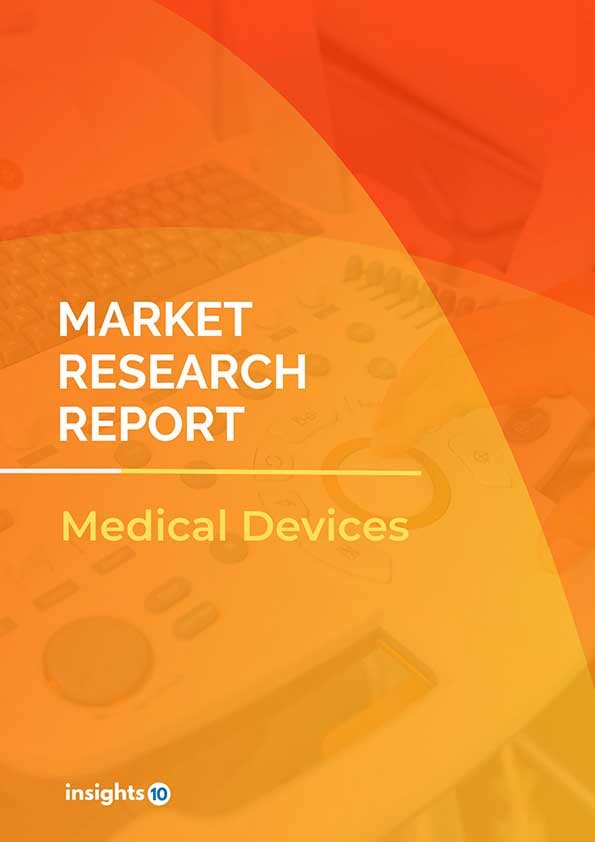US 3D Printing Medical Devices Market Analysis
The US 3D printing medical devices market is projected to grow from $1.2 Bn in 2022 to $3.6 Bn by 2030, registering a CAGR of 14.3% during the forecast period of 2022-30. 3D printing enables medical devices to be customized to the individual patient's needs, which can improve patient outcomes and satisfaction. The US 3D printing medical devices market is highly competitive, with several established players and new entrants vying for market share. Some of the major players in the US 3D printing medical devices market include Stratasys, Stryker Corporation, 3D Systems, and Materialise NV
Buy Now

US 3D Printing Medical Devices Market Executive Summary
According to projections, the US market for 3D-printed medical equipment would increase from $1.2 billion in 2022 to $3.6 billion in 2030, growing at a CAGR of 14.3% during the forecast period of 2022-30.
A fast-expanding area of the medical device business is the US 3D printing medical devices market. Additive manufacturing, also referred to as 3D printing, is the process of making three-dimensional objects by stacking different materials on top of one another. Implants, prosthetic limbs, and surgical instruments have all been produced using 3D printing in the medical device sector.
Many reasons, including the following, drive the US market for 3D-printed medical devices:
The variety of medical devices that may be produced using 3D printing has increased thanks to the introduction of new 3D printing materials and technology.
- Medical device customisation: 3D printing enables medical equipment modification based on specific patient requirements, which may enhance patient outcomes and lower healthcare expenditures
- Shorter Manufacturing Times: 3D printing may speed up the production of medical equipment, enhancing patient access to treatment and cutting down on wait times
- Cost-effectiveness: 3D printing may lower the price of making medical equipment, making healthcare for patients more accessible and inexpensive
The following are some of the major uses of 3D printing in the medical device sector:
- Custom orthopaedic implants, such as hip and knee replacements, are made possible through 3D printing.
- Custom prostheses are made via 3D printing, which may increase patient comfort and functionality.
- Dental Implants: Dental implants and other dental equipment are made via 3D printing.
- Medical devices, such as bone saws and retractors, are produced using 3D printing.
The US market for 3D printed medical products is very competitive, with both long-established companies and recent startups contending for market dominance. Stratasys, Stryker Company, 3D Systems, and Materialise NV are among the significant companies in the US market for medical equipment made using 3D printing technology.
.png)
Market Dynamics
Growth Drivers
Many reasons, including the following, drive the US market for 3D-printed medical devices:
- Improved Personalization and Customization: 3D printing makes it possible to tailor medical equipment to each patient's demands, which may enhance patient happiness and results
- Cost Savings: 3D printing makes it possible to produce medical equipment at a cheaper cost than conventional manufacturing techniques, which may benefit both patients and healthcare providers
- Shorter Time to Market: The ability to quickly prototype and develop medical equipment thanks to 3D printing may shorten the time it takes for new items to reach the market
- Growing Demand for Implants and Prosthetics: 3D printing is ideally suited for producing these kinds of medical devices, which are in high demand due to the ageing US population
- Technological Developments: The potential applications of 3D printing in the medical industry are growing as a result of technological developments in the field, such as the ability to print with a wider variety of materials
- Regulatory Support: Regulatory organisations like the FDA are supporting 3D printing in the medical industry more and more, which is encouraging adoption and investment
Obstacles to the US market for 3D-printed medical devices
The US market for 3D-printed medical equipment is additionally constrained by a number of factors, such as:
- Restricted Reimbursement Policies: The use of 3D printed medical equipment by healthcare providers may be constrained by the lack of well-established reimbursement rules
- Regulatory Challenges: While there is increasing regulatory support for 3D printing in medicine, there are still regulatory issues that need to be resolved, especially with regard to quality control and validation
- Problems with intellectual property Medical device 3D printing can raise issues with intellectual property, especially if the device is protected by a patent or trademark
- Limited Number of Skilled Professionals Available: There may be a scarcity of individuals with the particular knowledge and abilities needed to produce 3D-printed medical products
- Constrained Scalability 3D printing is now best suited for generating low-volume, high-value medical products, which may restrict scalability and profitability for certain firms
- Material Limitations: While the range of materials that can be used in 3D printing is expanding, there are still limitations on the types of materials that can be used for medical devices, particularly for implantable devices
Competitive Landscape
Key Players
The market is a highly competitive market with several key players, including:
- Stratasys Ltd.
- 3D Systems Corporation
- Materialise NV
- EOS GmbH
- SLM Solutions Group AG
- EnvisionTEC
Other notable players in the US 3D printing medical devices market include Renishaw, Oxford Performance Materials, and Arcam AB.
Healthcare Policies and Regulatory Landscape
The US 3D printing medical equipment industry is subject to a number of healthcare rules and regulations. The following are some of the important laws and agencies that regulate the market:
- Food and Drug Administration (FDA): The FDA oversees the design, manufacture, and sale of medical devices in the US, including those made by 3D printing. The organisation has published guidelines on the use of 3D printing in the manufacture of medical devices and has approved a number of them.
- Both Medicaid and Medicare, these publicly funded healthcare programmes provide insurance protection for diagnostic and therapeutic treatments, as well as 3D printed medical products. Some 3D-printed medical devices are eligible for coverage, but reimbursement policies are still being developed.
- The Affordable Care Act (ACA): The ACA has regulations governing medical devices, including those made with 3D printing. The law stipulates specific reporting and tracking requirements as well as the need for safe and effective medical devices.
- The National Institutes of Health (NIH) is a federal organisation that supports and carries out biomedical research. The organisation has contributed to research on 3D printing in the medical industry and has funded the creation of 3D-printed medical products.
- The International Organization for Standardization (ISO): The ISO is a non-governmental organisation that creates global standards for many different industries, including healthcare.
1. Executive Summary
1.1 Device Overview
1.2 Global Scenario
1.3 Country Overview
1.4 Healthcare Scenario in Country
1.5 Regulatory Landscape for Medical Device
1.6 Health Insurance Coverage in Country
1.7 Type of Medical Device
1.8 Recent Developments in the Country
2. Market Size and Forecasting
2.1 Market Size (With Excel and Methodology)
2.2 Market Segmentation (Check all Segments in Segmentation Section)
3. Market Dynamics
3.1 Market Drivers
3.2 Market Restraints
4. Competitive Landscape
4.1 Major Market Share
4.2 Key Company Profile (Check all Companies in the Summary Section)
4.2.1 Company
4.2.1.1 Overview
4.2.1.2 Product Applications and Services
4.2.1.3 Recent Developments
4.2.1.4 Partnerships Ecosystem
4.2.1.5 Financials (Based on Availability)
5. Reimbursement Scenario
5.1 Reimbursement Regulation
5.2 Reimbursement Process for Diagnosis
5.3 Reimbursement Process for Treatment
6. Methodology and Scope
US 3D Printing Medical Devices Market Segmentation
By Component
The US market is divided into three categories based on the component: equipment, materials, and software & services. End customers frequently employ software and services for designing and processing control of 3D-printed medical devices, particularly for bespoke items. The cost-effectiveness, utility, uniformity, and precision given by services for medical device 3D printing, together with a rise in demand for personalized 3D printed medical equipment among hospitals and surgical centers, are driving the market demand for software & surgical guides.
- Equipment
- 3D Printers
- 3D Bioprinters
- Materials
- Plastics
- Thermoplastics
- Photopolymers
- Metals and Metal Alloys
- Biomaterials
- Ceramics
- Paper
- Wax
- Other Materials
- Services & Software
By Application
The US market is divided into surgical guides, surgical tools, tissue-engineered goods, hearing aids, wearable medical devices/implantable medical devices, standard prostheses and implants, custom prosthetics and implants, and other medical devices based on the application. Due to the widespread adoption of 3D printing technology in the production of prosthetics and implants, the increased availability of high-quality biomaterials and ceramics for 3D printing, and ongoing industry investment in the development of novel 3D printers, the custom prosthetics and implants segment is expected to hold a larger share of the market in 2022.
- Surgical Guides
- Dental Guides
- Craniomaxillofacial Guides
- Orthopedic Guides
- Spinal Guides
- Surgical Instruments
- Surgical Fasteners
- Scalpels
- Retractors
- Standard Prosthetics & Implants
- Orthopedic Implants
- Dental Prosthetics & Implants
- Craniomaxillofacial Implants
- Bone & Cartilage Scaffolds
- Ligament & Tendon Scaffolds
- Custom Prosthetics & Implants
- Tissue-engineered Products
- Hearing Aids
- Wearable Medical Devices
- Other Applications
By Technology
According to technology, the global market has been divided into three categories: three-dimensional printing (3DP) or adhesion bonding; electron beam melting (EBM); laser beam melting (LBM); photopolymerization; droplet deposition or extrusion-based technologies; and other technologies. The laser beam melting (LBM) segment is anticipated to hold the greatest market share in 2022, in large part due to the growing use of this technology in the dental sector and for the production of implants for minimally invasive surgery.
- Laser Beam Melting
- Direct Metal Laser Sintering
- Selective Laser Sintering
- Selective Laser Melting
- LaserCUSING
- Photopolymerization
- Digital Light Processing
- Stereolithography
- Two-photon Polymerization
- PolyJet 3D Printing
- Fused Deposition Modeling
- Multiphase Jet Solidification
- Low-temperature Deposition Manufacturing
- Microextrusion Bioprinting
- Droplet Deposition/Extrusion-based Technologies
- Electron Beam Melting
- Three-dimensional Printing/Adhesion Bonding/Binder Jetting
- Other Technologies
By End User
The US market has been divided into hospitals and surgical facilities, dental and orthopedic clinics, academic institutions and research labs, pharma-biotech and medical device firms, and clinical research organizations based on end users. In 2022, hospitals and surgical centers are anticipated to hold the greatest market share. The high proportion of this market may be due to the ongoing expansion of internal 3D printing capabilities, the expansion of existing 3D printing laboratories, the rising affordability of 3D printing services, and the quick uptake of cutting-edge technology by hospitals in developed markets.
- Hospitals & Surgical Centers
- Dental & Orthopedic Clinics
- Academic Institutions & Research Laboratories
- Pharma-Biotech & Medical Device Companies
- Clinical Research Organizations
Insights10 will provide you with the reports within 10 key parameters which are:
- Market Overview
- Market Growth Drivers & Restraints
- Epidemiology of Disease Type
- Market Segmentation
- Market Share
- Competitive Landscape
- Key Company Profiles
- Healthcare Policies & Regulatory Framework
- Reimbursement Scenario
- Factors Driving Future Growth
Based on our many years of experience, we believe that these are the parameters that are critical to decision-making for business stakeholders. Our focused approach to developing reports focused on 10 key parameters, enabled us to arrive at the name “Insights10”.

Stage I: Market Data Collection
Primary Interviews: We have developed a network of experts, freelancers, and researchers across countries through which we engage with local experts to gather key data points and assumptions about each market. We also engage regularly with some of the best market research agencies such as Atheneum, GuidePoint, GLG, etc. to conduct surveys and interviews, and build intelligence. We have language translators as a part of our team, who between them can cover 30+ languages allowing us to extract better local insights.
Secondary Data Collection: We have developed strong expertise and experience in secondary data collection methods for developing unique data sets and research material. We gather data from multiple reliable sources to maintain a high level of accuracy and consistency. The market data is analyzed and forecasted using appropriate statistical and coherent models. The report offers an overall analysis of the market size, growth, and market share as well as a segment-level analysis of the specific market. Our report includes precise, to-the-point information related to the overall market, competition, growth drivers, challenges, regulatory updates, and competition.
Data Sources: We have access to multiple highly reliable free and subscription data sources. We have many years of experience to understand which sources are more dependable for what and which to prefer for the reliable and latest information. The key sources of information include the following, but are not limited to:

Stage II: Market Data Analysis and Statistical Model
Market Trends: We generally look at macro parameters and micro indicators. The macro parameters include changes in government policies, demand and supply of the market, government intervention programs, and major market share. The micro indicators are GDP growth, market size, market volume, etc. We also understand nuances specific to each country like the US, Canada, India, Germany, etc., and have worked across 60+ countries and hence not only understand global trends but how these differ by country, how payment models, market structure, cultural parameters, etc. differ in each country.
Market Sizing and Analysis: Our expert data analytics team has created various market forecast models by employing the top-down approach i.e. starting with the large overall market and segmenting different areas and the bottom-up approach i.e. starting with population and epidemiology and rolling up based on spend, etc., estimating the size of the market, and distributing among the geographic and/or product segments.
The top-down approach is mainly used for new product forecasting and the bottom-up approach is used for demand estimation of any product for different countries summed up to form the total market. We are able to round off insights and build stronger forecasts because we always do both these methods and triangulate the final numbers.
The study on the market covers the analysis of the leading geographies such as Asia-Pacific, Africa, Europe, Middle East, North America, and Latin America for the period of 2022 to 2030. The qualitative analysis covers the industry landscape and trends, market opportunities, competitive landscape, and policy and regulatory scenario, and the quantitative analysis covers different market estimates and forecasts.
Data Triangulation & Validation:
Data triangulation of various sources and results of the research are carried out by benchmarking with reliable sources such as industry statistics, statistical databases, and company-level averages, etc.
We make sure to finalize the numbers in alignment with the market research. Firstly, our internal experts ensure thorough validation and checking to ensure accurate and precise analysis and then validation is also done using a multiple-data analysis model. Two-level validation is done and entails the finalization of the report scope and the way of representation pattern.
(1).png)
Stage III: Interpretation and Presentation
Analysis & Interpretation: The information gathered is then analyzed and synthesized. The second series of interviews are done if necessary to check and validate. The future opportunities are analyzed by understanding product commercialization and many other factors. It also comprises the analysis of data discrepancies observed across various data sources. Information procured from secondary and primary results is then, interpreted by considering the following parameters: (a partial list)
- Establishing market drivers and trends
- Analyzing the regulatory landscape to understand future growth
- Market Segment based analysis to obtain revenue/volume
- Analyzing current needs and determining penetration to estimate the market
Insights: Our reports deliver actionable insights backed with supporting facts and figures to assist you in achieving exemplary growth. Our in-depth analyses are interspersed with relevant insights and statistics to offer an executive-level view of a given market. The description helps in correlating many minor factors affecting the market and their impact on the different segments within the market.
Data curated from the analysis and interpretation are drawn to portray all in one consolidated report.
Presentation & Reporting: The market research report is presented in different forms such as charts by using a scientific approach for easy understanding. Historic, current, and future analysis is provided for each market in terms of both value and volume. The size of the market is interpreted in the US Dollar value and the respective unit, based on the product, for volume consumption.
The foreign exchange rates are calculated on the respective dates and for the respective regions covered in the study.
To request a free sample copy of this report, please complete the form below.
We value your inquiry and offer free customization with every report to fulfil your exact research needs.
This report addresses
- Intelligent insights to take informed business decisions
- Qualitative, acute and result oriented market analysis
- Market size and forecasts from 2022 to 2030
- Opportunities for expansion and in-depth market analysis
- Segmentation and regional revenue forecasts
- Analysis of the market share and competitive landscape
- Strategic Recommendations to chart future course of action
- Comprehensive Market Research Report in PDF and PPT formats
Need more?
- Ask our analyst how this study was put together to learn more
- Discuss additional requirements as part of the free customisation
- Add more countries or regions to the scope
- Get answers to specific business questions
- Develop the business case to launch the product
- Find out how this report may influence your business revenue








































